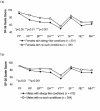Health-related quality of life among adolescents with allergy-like conditions - with emphasis on food hypersensitivity
- PMID: 15555064
- PMCID: PMC534793
- DOI: 10.1186/1477-7525-2-65
Health-related quality of life among adolescents with allergy-like conditions - with emphasis on food hypersensitivity
Abstract
Background: It is known that there is an increase in the prevalence of allergy and that allergic diseases have a negative impact on individuals' health-related quality of life (HRQL). However, research in this field is mainly focused on individuals with verified allergy, i.e. leaving out those with self-reported allergy-like conditions but with no doctor-diagnosis. Furthermore, studies on food hypersensitivity and quality of life are scarce. In order to receive information about the extent to which adolescent females and males experience allergy-like conditions and the impact of these conditions on their everyday life, the present study aimed to investigate the magnitude of self-reported allergy-like conditions in adolescence and to evaluate their HRQL. Special focus was put on food hypersensitivity as a specific allergy-like condition and on gender differences.
Methods: In connection with lessons completed at the children's school, a study-specific questionnaire and the generic instrument SF-36 were distributed to 1488 adolescents, 13-21 years old (response rate 97%).
Results: Sixty-four per cent of the respondents reported some kind of allergy-like condition: 46% reported hypersensitivity to defined substances and 51% reported allergic diseases (i.e. asthma/wheezing, eczema/rash, rhino-conjunctivitis). A total of 19% reported food hypersensitivity. Females more often reported allergy-like conditions compared with males (p < 0.001). The adolescents with allergy-like conditions reported significantly lower HRQL (p < 0.001) in seven of the eight SF-36 health scales compared with adolescents without such conditions, regardless of whether the condition had been doctor-diagnosed or not. Most adolescents suffered from complex allergy-like conditions.
Conclusions: The results indicate a need to consider the psychosocial impact of allergy-like conditions during school age. Further research is needed to elucidate the gender differences in this area. A team approach addressing better understanding of how allergy-like conditions impair the HRQL may improve the management of the adolescent's health problems, both in health-care services and in schools.
Figures



References
Publication types
MeSH terms
LinkOut - more resources
Full Text Sources
Medical

